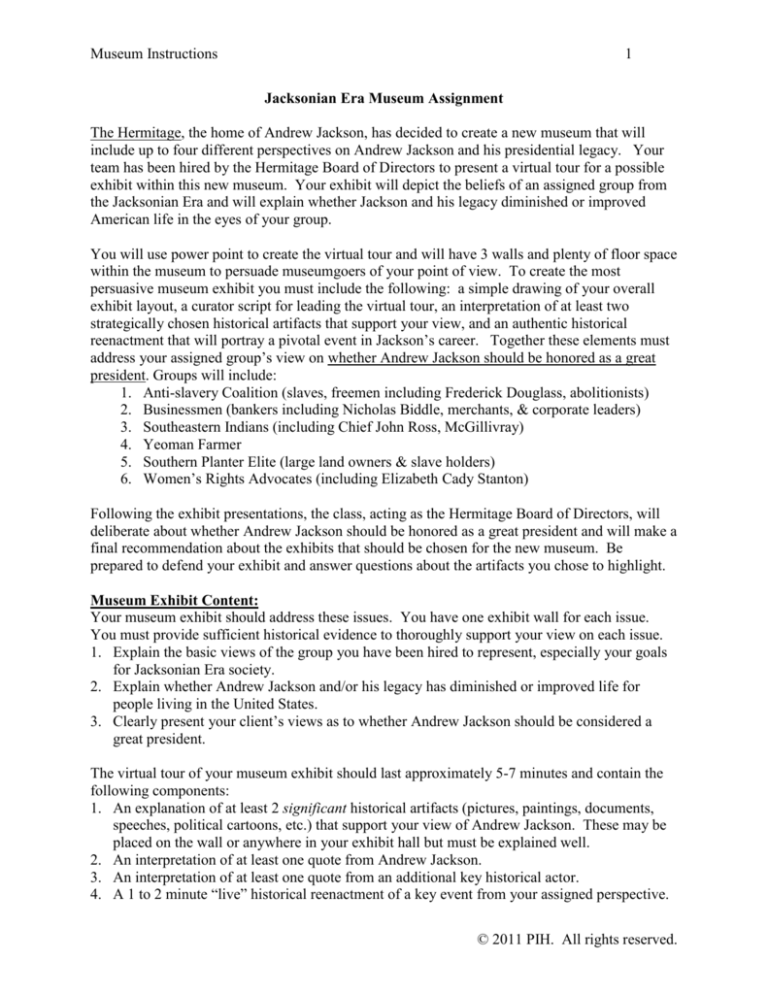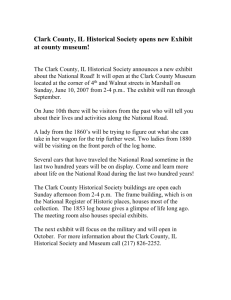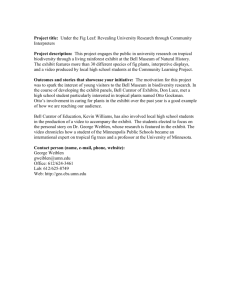
Museum Instructions
1
Jacksonian Era Museum Assignment
The Hermitage, the home of Andrew Jackson, has decided to create a new museum that will
include up to four different perspectives on Andrew Jackson and his presidential legacy. Your
team has been hired by the Hermitage Board of Directors to present a virtual tour for a possible
exhibit within this new museum. Your exhibit will depict the beliefs of an assigned group from
the Jacksonian Era and will explain whether Jackson and his legacy diminished or improved
American life in the eyes of your group.
You will use power point to create the virtual tour and will have 3 walls and plenty of floor space
within the museum to persuade museumgoers of your point of view. To create the most
persuasive museum exhibit you must include the following: a simple drawing of your overall
exhibit layout, a curator script for leading the virtual tour, an interpretation of at least two
strategically chosen historical artifacts that support your view, and an authentic historical
reenactment that will portray a pivotal event in Jackson’s career. Together these elements must
address your assigned group’s view on whether Andrew Jackson should be honored as a great
president. Groups will include:
1. Anti-slavery Coalition (slaves, freemen including Frederick Douglass, abolitionists)
2. Businessmen (bankers including Nicholas Biddle, merchants, & corporate leaders)
3. Southeastern Indians (including Chief John Ross, McGillivray)
4. Yeoman Farmer
5. Southern Planter Elite (large land owners & slave holders)
6. Women’s Rights Advocates (including Elizabeth Cady Stanton)
Following the exhibit presentations, the class, acting as the Hermitage Board of Directors, will
deliberate about whether Andrew Jackson should be honored as a great president and will make a
final recommendation about the exhibits that should be chosen for the new museum. Be
prepared to defend your exhibit and answer questions about the artifacts you chose to highlight.
Museum Exhibit Content:
Your museum exhibit should address these issues. You have one exhibit wall for each issue.
You must provide sufficient historical evidence to thoroughly support your view on each issue.
1. Explain the basic views of the group you have been hired to represent, especially your goals
for Jacksonian Era society.
2. Explain whether Andrew Jackson and/or his legacy has diminished or improved life for
people living in the United States.
3. Clearly present your client’s views as to whether Andrew Jackson should be considered a
great president.
The virtual tour of your museum exhibit should last approximately 5-7 minutes and contain the
following components:
1. An explanation of at least 2 significant historical artifacts (pictures, paintings, documents,
speeches, political cartoons, etc.) that support your view of Andrew Jackson. These may be
placed on the wall or anywhere in your exhibit hall but must be explained well.
2. An interpretation of at least one quote from Andrew Jackson.
3. An interpretation of at least one quote from an additional key historical actor.
4. A 1 to 2 minute “live” historical reenactment of a key event from your assigned perspective.
© 2011 PIH. All rights reserved.
Museum Instructions
2
In addition to the above components, your museum exhibit must include your client’s views on
at least 5 of the following topics1:
1. Jackson's Leadership Style
2. Battle of New Orleans
3. 1824 election
4. 1828 election
5. The Veto
6. Democratic Party
7. Spoils System
8. Indian Removal
9. Bank War
10. Rise of Corporations
11. Decline of Southern Plantations
12. Nullification
13. Slavery
14. Suffrage / Political Participation
15. Internal Improvements
Remember that your museum exhibit presentation will compete against others like it and
therefore must gain attention, be professional, and be persuasive. It should stay faithful to the
experiences and beliefs of your assigned group. As you plan your exhibit, consider how you
may use images, physical artifacts, documents, and historical quotations to convey humor, fear,
sympathy, etc. Consult the models that your teacher has presented to help you plan the exhibit.
Remember to explain the legacy of Jackson you feel the American public should know.
Museum Exhibit Presentation Construction Process:
A.
Group Roles
Each student will be assigned one of the following roles in the presentation process:
Curator: Primary responsibilities for narrating and leading exhibit presentation. Leads
group to ensure conceptual unity. Creates sketches and writes narrative explaining each
exhibit wall. Assists historian in placing artifacts in exhibit.
Historian: Primary responsibility for finding, interpreting and presenting historical
artifacts in support of client’s view. Locates historical quotes. Creates narrative for this
portion virtual tour. Works with curator to place artifacts within exhibit. Decides if any
artifacts should be given as a handout to audience.
Re-enactor: Primary responsibility for scripting, organizing, and leading “live”
reenactment of key historical event. Creates narrative for this portion of storyboard.
Technician: Primary responsibility for producing and running technology supporting
presentation. Creates the technical directions on scaffolds, locates the visual images, and
any other digital media the group will use.
1
Potential topics adapted from list prepared by PBS for Andrew Jackson: Good, Evil & the Presidency.
http://www.pbs.org/kcet/andrewjackson/
© 2011 PIH. All rights reserved.
Museum Instructions
B.
3
Project Checklist
Have your teacher review your ideas and initial your Checklist at each stage indicated
below:
1. Read and discuss summary of assigned perspective.
____________
2. Examine resources for your group on the Museum Exhibit Planning Resource
Page. These will provide you with helpful links for learning more and finding
artifacts.
3. Use the Brainstorming Guide to help you plan for information, arguments, and
media to be used in the virtual tour of your museum exhibit. Discuss the
questions carefully.
____________
4. Use Storyboard to complete a rough draft for the presentation.
____________
5. Produce a final Storyboard.
6. Use final Storyboard to rehearse the actual presentation including all technical
elements.
C.
Brainstorming Guide for Planning Your Museum Exhibit
Based on all of the information at your disposal, consider the following questions:
o What are the views of your group? What is their goal for society? What
would your group want others to know about Jackson or this time period?
o What are your group’s experiences with Andrew Jackson? If they do not have
direct experience with him, what is your group’s view of Andrew Jackson?
Would they like or dislike his policies? If your group seems to have different
views of Jackson, what do they all agree on?
o Which five events should you weave into your exhibit? Consider the events
from the list that best help you make your case about Andrew Jackson and his
legacy.
o What quotes might be used to support your arguments? Are there quotes from
opponents or Jackson himself that could be used to make him look good or
bad?
o What images, documents, or artifacts could be interpreted to support your
argument? Should any of these be given out as handouts?
o Should Andrew Jackson be remembered as a great president? Does your
whole exhibit make a clear case?
© 2011 PIH. All rights reserved.
Museum Instructions
4
Assessment Criteria
Group
Rating
I. Museum Exhibit Presentation Content
1. Museum exhibit presentation demonstrates adequate
understanding of the facts and arguments surrounding the issue.
2. Museum exhibit presentation presents persuasive evidence and
arguments for the client’s point of view.
3. Storyboard clearly shows strong preparation, presentation
content, and cites sources for all historical information.
II. Museum Exhibit Presentation Composition
1. Museum exhibit presentation clearly communicates ideas.
2. Museum exhibit presentation flows smoothly and works together
to provide a consistent argument.
3. Museum exhibit presentation demonstrates a creative and unique
combination of information to present a persuasive argument.
4. Final presentation is polished and appealing.
Assessment Totals
Overall Assessment:
Description of Criteria Ratings:
5 = Exemplary: Goes beyond expectations to create original, highly insightful work.
4 = Competent: Meets expectations. Work is accurate and thorough.
3 = Acceptable: Meets most expectations with only minor omissions or inaccuracies.
2 = Needs Significant Improvement: Work has major omissions, inaccuracies.
1 = Unsatisfactory: Fails to meet minimal standards for quality work.
© 2011 PIH. All rights reserved.







